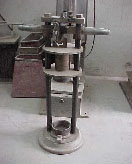AGGREGATE IMPACT VALUE
This test is done to determine the aggregate impact value of coarse aggregates as per IS: 2386 (Part IV) – 1963. The apparatus used for determining aggregate impact value of coarse aggregates is
Impact testing machine conforming to IS: 2386 (Part IV)- 1963,IS Sieves of sizes – 12.5mm, 10mm and 2.36mm, A cylindrical metal measure of 75mm dia. and 50mm depth, A tamping rod of 10mm circular cross section and 230mm length, rounded at one end and Oven.
Preparation of Sample
i) The test sample should conform to the following grading:
– Passing through 12.5mm IS Sieve – 100%
– Retention on 10mm IS Sieve – 100%
ii) The sample should be oven-dried for 4hrs. at a temperature of 100 to 110oC and cooled.
iii) The measure should be about one-third full with the prepared aggregates and tamped with 25 strokes of the tamping rod.
A further similar quantity of aggregates should be added and a further tamping of 25 strokes given. The measure should finally be filled to overflow, tamped 25 times and the surplus aggregates struck off, using a tamping rod as a straight edge. The net weight of the aggregates in the measure should be determined to the nearest gram (Weight ‘A’).

Procedure to determine Aggregate Impact Value
i) The cup of the impact testing machine should be fixed firmly in position on the base of the machine and the whole of the test sample placed in it and compacted by 25 strokes of the tamping rod.
ii) The hammer should be raised to 380mm above the upper surface of the aggregates in the cup and allowed to fall freely onto the aggregates. The test sample should be subjected to a total of 15 such blows, each being delivered at an interval of not less than one second.
Reporting of Results
i) The sample should be removed and sieved through a 2.36mm IS Sieve. The fraction passing through should be weighed (Weight ‘B’). The fraction retained on the sieve should also be weighed (Weight ‘C’) and if the total weight (B+C) is less than the initial weight (A) by more than one gram, the result should be discarded and a fresh test done.
ii) The ratio of the weight of the fines formed to the total sample weight should be expressed as a percentage.
Aggregate impact value = (B/A) x 100%
iii) Two such tests should be carried out and the mean of the results should be reported.
If you have a query, you can ask a question here.



ThanxzZZ
what is meant by impact value, and how to calculate the impact value
the calculation of AIV is, total weight of sample=A
reation weigh of 2.36is sieve =B
Passing weight of2.36is sieve=c
Aiv=b/a*100
Hi! Thiz syt iz the most educative of ol I’ve evr googled. Keep it up!
thnx a lot
what should be impact value for concrete work
if it is <50% it is better to use construction,o/w not use
it depends on where concrete is using …it should not more than 30%
it can be more than 30% for non wearing surface…………. for non wearing surface its max. limit is 45%
very useful site for civil engineers
This is the best site for all practicals
it is very useful test of aggregate
i. the importance of the AIV value to the pavement?
ii. the importance of AIV test?
helo..may i know the specification JKR of this test,mean their percent wear?
A perfect site for civil engineers
very useful & good one for Civil Engineer’s
tests on samples of two different coarse aggregates yielded aggregate crushing values of 14% and 20% respectively.which aggregate is stronger and why?
two samples of cutback bitumen have standard tar viscosities of 75secs at 25C and 40C respectively which is more viscous and why
Thanks yaar, this is so useful for us…
i need a reference standard with limits for aggregate crushing values(ACV) for coarse aggregate for 15/20 to 30/40 concrete
1)what is meant by toughness of the aggregate? 2)how does toughness differ from compressive strength? 3)what are uses of determining impact value?
should a good quality road aggregate give higher impact value?
what will be the lower and higher values of impact value
and what is the permissible values